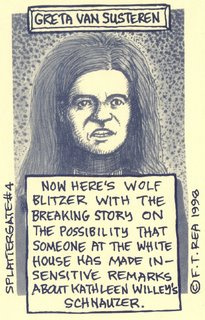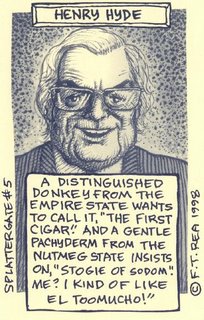 Note: The piece below was originally published by STYLE Weekly in 2007. The recent chatter about a giant Confederate flag waving over a highway into Richmond made me want to post it here. A few years ago, a retired educator gave me the history book mentioned in the piece. I hope he enjoys seeing what his gift inspired.
Note: The piece below was originally published by STYLE Weekly in 2007. The recent chatter about a giant Confederate flag waving over a highway into Richmond made me want to post it here. A few years ago, a retired educator gave me the history book mentioned in the piece. I hope he enjoys seeing what his gift inspired.
*
Having grown up in Richmond, I've been steeped in its dual sense of
bitterness and pride over matters to do with, and stemming from, the
Civil War. Perhaps thinned out somewhat by time, it remains in the air
we breathe at the fall line of the James River.
Most of my life has been spent in the Fan District, which is home to
four statues honoring heroes of the Confederacy. Beyond monuments, to
know what it was like in Richmond in the past, we look to history. It
comes to us in many ways — stories told, popular culture and schooling
among them.
In 1961, my seventh-grade history book, which was the official history
of Virginia for use in all public junior high schools — as decreed by
the General Assembly — had this to say about slavery at the end of its
Chapter 29:
Life among the
Negroes of Virginia in slavery times was generally happy. The Negroes
went about in a cheerful manner making a living for themselves and for
those whom they worked. They were not so unhappy as some Northerners
thought they were, nor were they so happy as some Southerners claimed.
The Negroes had their problems and their troubles. But they were not
worried by the furious arguments going on between Northerners and
Southerners over what should be done with them. In fact, they paid
little attention to those arguments.
In 1961 I had no reason to question that paragraph's veracity. Baseball
was my No. 1 concern in those days. Now those words read quite
differently.
Living through the struggles of the Civil Rights era, with its bombings,
assassinations, marches, sit-ins, boycotts and school-closings, did
much to show me a new light, to do with truth and fairness. However, for
me, there was no moment of epiphany, no sudden awareness I was growing
up in a part of the world that officially denied aspects of its past.
More than anything else, it took time. Life experience taught me to look
more deeply into things.
Now I know that dusty old history book was a cog in the machinery that made the Jim Crow era possible.
Nonetheless, that same history book's view of how it was for those
enslaved is one that some Virginians still want to believe. It's
probably what they were taught as children, too. Some call it
"heritage." Many of this persuasion also cling to the bogus factoid that
since most Southerners didn't hold slaves, the Civil War itself was not
fought over slavery.
Which is preposterous.
Of course poor Southerners, those who weren't plantation owners, had
little to do with starting the Civil War. Generally speaking, poor
people with no clout don't launch wars anywhere; rich people with too
much power do.
So, for the most part, the men who fought in gray uniforms were doing
what they felt was expected of them. As with most wars, the bulk of
those who fought and died for either side between 1861 and 1865 were
just ordinary Joes who had no say-so over declaring war or negotiating
peace.
In Virginia, many who chose to wear gray did so to reverse what seemed
to them to be an invasion of their home state. That's the reason the
heritage clingers like the best.
Yet, if the reader wants to understand more deeply why Virginia
eventually left the Union, to follow the secessionist hotheads of South
Carolina and Mississippi into war, here's a clue from Chapter 30 of that
same history book, which opened with this:
In 1790 there were more than 290,000 slaves in Virginia. This number was larger than that of any other state.
Those 290,000 slaves were worth a lot of money to their owners and such wealthy families had a lot of say-so.
Thus, the largest part of the real blame for the bloodshed of the war,
and the subsequent indignities of the Reconstruction era, probably rests
with wealthy slaveholders who would not give up their investments in
cheap labor without a fight.
Readers interested in how much the official record of the Civil War has
changed over the decades since the Civil Rights era should pay a visit
to the Virginia Historical Society in Richmond. Its telling of the story
of the Civil War is now based on the unvarnished truth.
Moreover, I am proud to be a Virginian. There's plenty of Virginia
history that has nothing to do with picking sides in the Civil War. My
ancestors go back to the 1600s in this commonwealth. But I will not
stand with anyone who chooses to stay the course with the absurd denials
of history — to do with slavery — that were crammed into that old
public school textbook.
As for my friends in Richmond who haven't had a fresh thought on matters
racial since they were seventh-graders, well, I don't want to pick a
fight with them. So mostly we talk about other things — baseball still
works.
All that said, Robert E. Lee, whose spectacular monument I see every
day, remains a Virginian I admire. I realize his reputation has taken
somewhat of a beating in recent years, but the dual sense of tragedy and
dignity his statue conveys remains striking. In his time and place,
torn between loyalties, it seems to me Lee tried to do what he saw as
his duty.
After the war a weary Lee urged his fellow Virginians to let it go — to move on. That was good advice in 1865. It still is.
-- 30 --
Note: The illustration was fashioned after Jean Antoine Mercie's Lee
Monument (unveiled in 1890). "Mercie's Lee," by yours truly, was done in ink
and pastels.

















